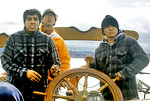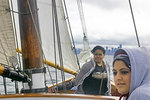For the first overnight trip of her 100th year, the schooner Adventuress boarded 37 souls on April 3 at Seattle’s Elliott Bay Marina. Her timbers, well seasoned with decades of laughter, seemed to …
This item is available in full to subscribers.
We have recently launched a new and improved website. To continue reading, you will need to either log into your subscriber account, or purchase a new subscription.
If you had an active account on our previous website, then you have an account here. Simply reset your password to regain access to your account.
If you did not have an account on our previous website, but are a current print subscriber, click here to set up your website account.
Otherwise, click here to view your options for subscribing.
* Having trouble? Call our circulation department at 360-385-2900, or email our support.
Please log in to continue |
|


For the first overnight trip of her 100th year, the schooner Adventuress boarded 37 souls on April 3 at Seattle’s Elliott Bay Marina. Her timbers, well seasoned with decades of laughter, seemed to sigh with relief as the young voices, nervous at first, met the crew and stood out for new harbors, new friends, new challenges and new perspectives.
The 21 students and two chaperones were from New Start, a small alternative high school in White Center, Wash., part of the Highline School District. New Start provides one last chance to young adults who had trouble succeeding in conventional schools. Many had never been on a boat before; several looked a bit bewildered. Seven of the students were born in Mexico, and two in California; others hailed from Texas, El Salvador and American Samoa. They were there to earn a half-credit toward graduation, but it was clear to everyone that what they would take away would be much more profound.
Nobody is sure of what to expect when boarding a ship for a three-day tour. After some introductions and a short safety speech, it was time to leave the dock and make sail, with everyone pulling together on the halyards and deckhand Julia belting out the verses of the well-worn shanty “Rolling Down to Cuba.” The engine shut down, and water could be heard gurgling along the hull as the broad decks took on a gentle slope.
“I love that feeling of just getting pulled along by the wind,” observed Perry, a student who grew up in a house behind the Taco Bell in White Center.
The mood was relaxed. Watch groups – eight students led by two crew members – were formed, and in their groups the students were shown every part of the ship. It is a gentle, slow, but efficient mode of instruction, personalized by deliberate questioning on the part of the crew, who give their groups ample time to voice concerns, ask questions and process the astounding amount of new information. Reflection is a keyword in the onboard educational methodology.
“A goal,” said Capt. Dan Evans, “is to give participants the opportunity to challenge themselves – to let themselves be challenged.”
Emphasis on fun is also obvious. Goofiness is the keynote. To announce lunch, deckhand Alea appeared on deck dressed as a giant banana, followed by a fuzzy character wearing an odd hat, and then a giant tomato. A grin-heavy pantomime conveyed the concept of grilled cheese and tomato soup.
The infallible combination of lunch and a sunny afternoon of light-air sailing worked its magic. The laughter became less nervous, the stories became louder.
Many of the kids spoke Spanish together. All were remarkably considerate. Most had a sober maturity in their eyes that seemed out of place for such young people.
One of the chaperones, Antonio, said, “They need somebody that’s gonna encourage them, not talk down to them. A lot of them you can tell what they’ve been through. They got this wall up. You’ve got to gain their trust before they open up to you.”
STREET SMARTS
In the main hold on the second evening, Kevin, Armando and Dario talked about how little school meant to them. They spoke Spanish primarily, but now and then a story came out in English. Armando told of a friend who had been in jail for two years. “He’s 13 with a couple felonies already. He’s dropped out of school ... but he’s smart, bro. He’s street-smart.”
Carlos was a clear leader, a handsome young man with a centered bearing and watchful, intelligent eyes. Under his black knitted hat, his hair was so black it was almost blue. His clothing was neat, gray, unadorned with logos. He wore skate shoes and a blue handkerchief around his neck. He didn’t want his picture taken. “The only shots of me are my mug shots,” he said.
Carlos described starting school at Skyway, a school in South Seattle known as a go-to spot for students who are in South End gangs and likely to run into rivals in other parts of the city.
“I was totally blued out in this blue Dickies suit,” Carlos said. He mimicked the looks he got and continued his tale in Spanish, mentioning the juez and la policia. “Once I started ninth grade, I was three months out,” he said.
The other boys listened closely. It was not unlike a seasoned tar talking to other sailors about a storm or a shipwreck.
They talked about the unfamiliarity of being on the boat. “All these kids gave up all their necessities and all the things they’re used to,” he said. “We’re out here without no phone; there’s a lot of people out there without no home.” When asked how he felt about being on board, he said, “I kinda like it,” and compared the experience – favorably – with being in prison. “It’s a lot of people in a small space on this boat, but you’re free.” He described the feeling of suffocation in prison. “Think about how prisoners do it. I don’t like walls. No RJC [Regional Justice Center]. No King County.”
Another student, Brady, had the task of taking photos during the trip. He said his photos have been displayed at an ice cream shop in White Center, and that he likes photography because “anytime you snap a photo, you capture a moment that nobody will ever see that way again.” Brady, 20, moved to Seattle a few years ago to avoid the life path of his cousins on the Lummi reservation, all of whom, he said, “are either buried or married.” His mom dealt drugs a lot when he was a kid, he said. “A moment comes when you decide to make a change.”
He came to New Start last year and plans to go to college at Western Washington University or at the tribal college in Ferndale, and possibly become a counselor for the youth of his tribe. “I keep on my nephews because they’re starting to get more of a social life,” Brady said. “It’s a vulnerable age. I don’t want them to struggle.”
TALK IT THROUGH
The school’s “administration has been very intentional” about how they have organized the school, said chaperone Kelsie Maney, who teaches chemistry and biology at New Start. Intentionality is also a theme in the experiential approach to education practiced aboard the schooner.
It’s a new educational model, explained Evans. The schooner’s crew of educators/deckhands is trained in “having participants focus on their own experience of being on the boat, rather than solely delivering content” (i.e., learning about marine ecology). “There is a lot of debriefing.”
The vegetarian meals, shared chores, low-tech fun (much louder than any video) and other unfamiliar parts of shipboard life were just some of the new experiences found aboard. The students dragged for plankton using a fine mesh contraption, and using a microscope hooked up to a laptop computer screen, got a closer look at the tiny, wriggling copepods. They learned about ocean acidification and tested the pH of water samples. They checked out the crab, sea cucumber and starfish in the on-deck aquarium.
Led by the crew, they reefed the mainsail, hauled the anchor, set the sails and handled the sheets. All of the students took advantage of the chance to climb aloft, even though it was scary, and most rowed in Ayashe, the small boat.
With the schooner anchored at Port Madison on the north end of Bainbridge Island, students climbed out along the bowsprit to furl the jib. Going out on the headrig, balancing on narrow cables above the cold green water, scared them and challenged them, and the crew is trained to help the students make the most of this experience. In debriefing sessions after the fact, students shared their experiences with their watch groups.
“I have fear and I do it and I don’t have fear anymore,” said Armando to his group as they debriefed in the bowsprit netting. Once you’re used to it, it’s a comfortable place to be, bundled up in rain gear and lifejackets, which serve to insulate and cushion. Lounging in the net at the bow, with the anchor chain slanting away below and the horizon wide with sea and sky, it was peaceful and felt a bit otherworldly. But the students seemed completely at ease there, suspended about 4 feet above the water, and they spoke with relative freedom about their experiences.
“I know this trip’s just for school,” said Caitlyn, “just for a half-credit, but there’s so much more to take out of it.”
“My favorite part was climbing the shrouds,” Fale said. “I got scared halfway up, but I thought to myself, this is the only time I get to do this. And I kept going.”
“You can feel the difference in the oxygen when you’re up there,” said Antonio.
Luis chimed in, “My favorite part is working as a team, because I really like working as a team. It makes me feel good.”